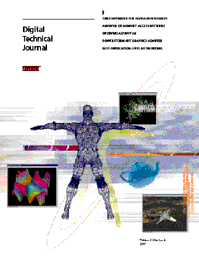|

Jane C. Blake,
Managing Editor
In 1992, DIGITAL announced the fastest 64-bit RISC
microprocessor, the Alpha, with a clock rate of 200 MHz.
Today’s Alpha processor remains the leader in
performance; the newest generation operates at 600 MHz,
and the next generation will operate at greater than
1,000 MHz—gigahertz speed. With the industry’s
most powerful processor in hand, DIGITAL’s engineers
are working to apply Alpha in different areas of
computing and effect optimal solutions to computing
problems. Samples of that work are presented in this
issue and include programming performance tools, the
OpenVMS operating system for very large memory (VLM)
applications, graphics adapters for workstations, and the
DART network adapter for high-end systems.
Spike is a profile-directed performance tool for
optimizing Alpha executables running on the Windows NT
operating system. Designed specifically to improve the
performance of large, call-intensive programs, such as
commercial databases, CAD programs, compilers, and
productivity tools, Spike has been shown to speed program
execution by as much as 33 percent. Robert Cohn, Dave
Goodwin, and Geoff Lowney describe Spike’s two
components. The Optimizer modifies code layout to improve
instruction cache behavior and performs hot-cold
optimization to reduce the number of instructions
executed on frequent paths through the program. The
Optimization Environment collects, manages, and applies
profile information transparently for the programmer.
An experimental Atom-based performance tool presented
by Susanne Balle and Simon Steely provides programmers
with an understanding of the access pattern behavior of
their technical applications. The tool generates
histograms for each memory reference in a program, thus
allowing the programmer to spot bottlenecks. The authors
step through an instructive case study in the use of the
tool with Fortran programs, showing how different
compiler switches affect the execution of a program
algorithm.
The OpenVMS Alpha operating system version 7.1 extends
its support for VLM applications. The design work
discussed by Karen Noel and Nitin Karkhanis focused on
increasing flexibility for VLM applications and on adding
system management capabilities. Areas reviewed are the
shared memory objects designed to improve application
scaling on the system, shared page tables to reduce
application start-up/shut-down times, and the physical
memory reservation system to allow efficient application
use of system components, namely the translation buffer.
DIGITAL’s PowerStorm series of graphics adapters
for mid-range workstations provides exceptional
performance on the DIGITAL UNIX and the Windows NT
operating systems. Benj Lipchak, Tom Frisinger, Karen
Bircsak, Keith Comeford, and Mike Rosenblum have written
an informative tutorial about the PowerStorm adapter
design that was shaped in large part by the existing
competitive environment. Their discussion covers selected
benchmarks and real-world performance experiences, the
advantages and disadvantages in choosing a
direct-rendering or an indirect-rendering scheme, and the
ways in which the engineering team exploited the Alpha
microprocessor’s exceptional floating-point speed.
DART is a 622-megabit-per-second network adapter that
connects gigabit-class networks to gigabit-class I/O
buses. It is designed to increase network throughput and
decrease system overhead. Bob Walsh explains that the
DART project, started in the late 1980s, anticipated the
need to address fundamental memory bandwidth bottleneck
issues from a system-level perspective. The main approach
taken in the DART adapter is data copy avoidance, without
requiring changes to system call semantics.
The upcoming Journal will be a special issue
that features papers on programming languages and tools.
Topics include C and Fortran parallelizing compilers, the
C++ template facility, alias analysis algorithms,
debuggers, and performance tools for software running on
the Windows NT, UNIX, and OpenVMS operating systems.
|
|